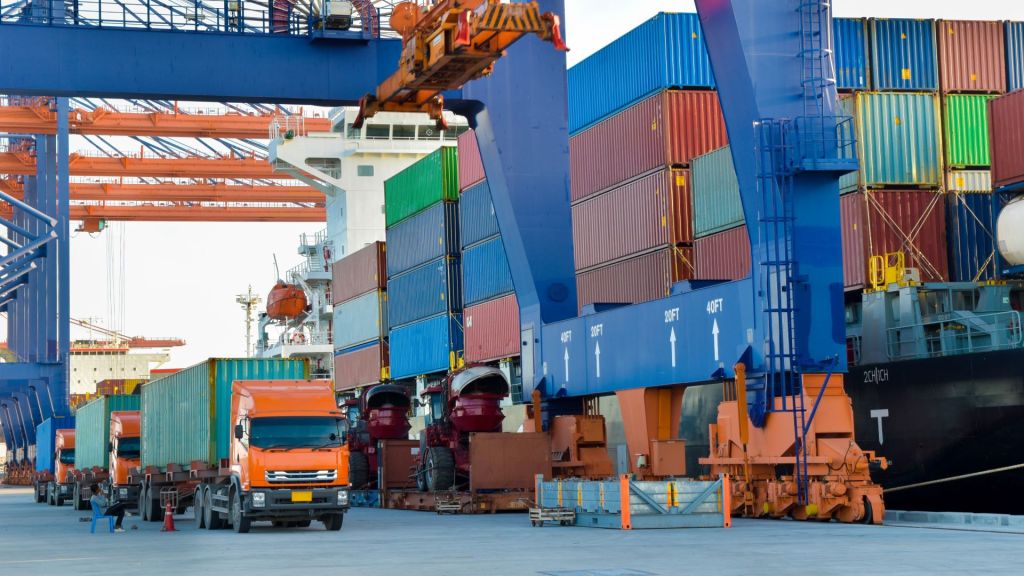Imagine it: your property, November 1st, 2021. Your team is scheduled to turn six units when you get a numbing report. Your trusted suppliers are out of stock on carpet and semi-gloss paint for trim. You scramble to find a new supplier, but the cost is 14% higher and expedited shipping costs are extreme. It’s not an unlikely scenario, and you can potentially avoid it. More than 80% of the world’s goods are transported by sea. The latest records indicate that sea freight charges have increased by 547% over their seasonal average. The result on land will be more out-of-stock items and higher costs on everyday goods for your property. Property managers would be wise to plan ahead on items that they need most. International cargo shipping rates and times increase The average price of a 40-foot shipping container has quadrupled from this time last year and there was a surge of more than 53% in July, reports the Wall Street Journal. Congested ports are one of the leading problems. In the first five months of 2021, Sea-Intelligence ApS of Denmark reported record-breaking delays. Nearly 700 ships were more than a week late to their destinations along the West Coast. For comparison, there were 1,535 late arrivals throughout all of 2012-2020. This summer, a daily average of 30 containers wait in queue outside of the Ports of Los Angeles. Other factors include a shortage in containers, skeleton crews at docks, labor shortages at manufacturers and rising demand as retailers reopen in the West. When might delays plateau? Analysts foresee serious delays at least until after the Lunar New Year of 2022, mid-February at the earliest. Most Chinese factories shut down for the holiday, halting production and shipping. This may afford a few days where in-progress shipments continue while manufacturing pauses (temporarily easing the influx of ships to ports). But once workers return, they’ll have to play catch up. The delays will continue, at least for a while. How do shipping delays impact property owners? Brian Bourke, chief growth officer at Seko Logistics based in Itasca, Ill. recommends placing large trans-Pacific orders at least two months in advance of normally anticipated dates. “Global trade right now is the hottest restaurant in town,” he said. “If you want to get a reservation, you need to plan it out two months in advance.” As a result, property managers can expect shipping delays and higher prices on imported goods. Though the shipping backlog has been growing for months, price increases were nominal and less frequent. Companies lock in contractual rates with container lines. Yet as their annual contracts end, new contracted rates will reflect higher shipping costs which will, in turn, be passed to consumers. HSBC Holdings Plc estimates that a 205% increase in freight costs translates to about a 2% price increase for European producers. (The cost increase is currently closer to 550%.) Canadian businesses are passing price increases as high as 20% on to consumers for bulky items like appliances. Estimates on U.S. consumer price increases vary, but the consensus is that prices will rise. Some goods simply won’t be available, large and small items alike. From the coffee stocked in the leasing office to furniture for furnished units, “temporarily out-of-stock” will become common on supplier websites. In these cases, freight costs can compose more than 60% of product cost, become cost prohibitive for suppliers. Property manager game plan A few tips can help property managers navigate the turbulent waters ahead. Plan ahead. Use reporting tools in your maintenance operations software to understand your fall and winter trends for supplies. Transparency into maintenance operations facilitates better foresight and planning. Review what you’ve spent on supplies in previous falls and winters. This may give you a baseline of what to expect. Take a moment to research available data on price increases and shipping delays in your market. That information will allow...
Simple, Streamlined Procurement
Yardi Marketplace & HD Supply Canada
Efficient, automated procurement and single-point supplier management are within reach. Through Yardi Marketplace, HD Supply Canada offers tools of the trade for multifamily, hospitality and healthcare property managers. It is a collaboration that empowers clients to work with greater simplicity, efficiency and savings. For Munawar Quraishi, general manager for HD Supply Canada Inc., teaming up with Yardi was a merging of interests. Both organizations emphasize caring for employees, clients and the community. Quraishi says, “Improving our people’s lives is at the core of everything we do. We know that having engaged, successful people within our business will drive the success of the organization.” He continues, “We look at the right balance of people, profit and processes.” To enhance its processes, HD Supply Canada sought a collaborator with similar perspectives on innovative technology. Together, Yardi and HD Supply Canada aim to advance the future of maintenance, repair and operations (MRO) buying and distribution. HD Supply, Canadian market leaders HD Supply Canada is the leading supplier of MRO products for multifamily living, hotels and long-term retirement care in the nation. Its pick, pack and distribute business model offers next day shipment. Product availability constantly grows: currently, HD Supply Canada offers 14,000 SKUs. Within the next several years, the goal is to get over 100,000. The process includes consulting subject matter experts on new products so that clients can rest assured they’re getting high quality and value. “Our sales team engages with vendors and peers to research and give our customers the best solution,” says Quraishi. Getting quality products into the hands of clients has involved process innovation at HD Supply Canada. The supplier was determined to implement digital solutions that streamline processes for its staff and its clients. HD Supply Canada + Yardi Marketplace add value for clients “Yardi Marketplace helps us act as solution providers for our customers, not just transaction executors. Having one platform for orders, payment and analytics will give our customers a previously unattained degree of visibility and help improve their productivity,” explains Quraishi. Previous transactions occurred via fax, email, phone and website. This approach resulted in unnecessary time delays and errors. “Yardi’s integration takes away the ambiguity of purchase order development before it gets to us, whether that’s a price change, error or issue with the print catalogues,” says Quraishi. An online marketplace also allows property technicians to maximize their time by using a mobile-ready service to place orders while they’re in the field. Clients note that site-level productivity has improved once operating on Marketplace. Additionally, HD Supply Canada conducts enterprise resource planning (ERP) through Marketplace. This allows the customer to make better decisions around budget and pricing. “This technology was a big play for us: it allowed property owners to understand how they’re spending dollars, especially in a time like today with COVID-19 where budgets and working capital become more important,” Quraishi says. “Such budget and capital insights allow clients better visibility than they had in the past.” Pouring (not trickling) the savings to clients Improved efficiencies within HD Supply Canada have a resounding impact on clients. HD Supply Canada reports that Yardi Marketplace has facilitated fewer price discrepancies, fewer errors with purchase orders and better visibility into approvals and budgeting. The organization now picks, packs and ships without completing the approval process via disparate systems and methods. The streamlined approach expedites business at multiple levels. The future of technology in MRO buying + distribution Quraishi and his team collaborate with technology companies like Yardi to usher the distribution industry into the future. “We believe technology is the solution to help us grow and we will grow with it,” says Quraishi. “Our investment in technology allows us to enhance the customer experience. We believe our system will pull information quickly and provide superior data to our clients. Those resources will help customers understand what they are buying, standardize those purchases and realize cost savings in the...
Kaiserman Company
Goes Green with Yardi
Arriving at the Rittenhouse Claridge in Center City Philadelphia on a cold winter’s night in January, the first thing you might notice is a charming string of white holiday lights over the lobby door. Stepping out of the cab into sub-freezing temperatures with wind chill, ducking inside the warm and welcoming lobby felt like stepping into the apartment of a dear friend. We were visiting Philadelphia to see first-hand how Yardi client the Kaiserman Company uses Yardi’s Procure to Pay platform to optimize its procurement process, streamlining ordering and delivery and making invoice approvals easier than ever before. Procure to Pay has helped Kaiserman save $60,000 annually, reduce paper use by 50 percent, and redirect staff time to other important tasks. The company uses the Yardi Voyager platform for its multifamily and commercial portfolios, and after implementing two years ago, has found the cloud-hosted solution to be invaluable. “We love it. I have been in the industry for awhile, used many different platforms, and Yardi is by far my favorite. Our leasing teams, our management teams and even our corporate office have access to Yardi. It just makes doing everyday tasks simpler,” said property manager Eric Schulz. The Rittenhouse Claridge One of just two apartment buildings located right on Philadelphia’s iconic Rittenhouse Square, the Rittenhouse Claridge was built in the 1950s by its current owner/operators, the Kaiserman Company. Over the last several years, an effort to restore the property to its midcentury roots has been underway, with charming results. On the building’s second floor, a sprawling common area with comfortable seating, fireplaces, reading nooks, game tables, a kitchen and private meeting spaces overlooks the Square. In one corner is the spacious gym, where a line of treadmills looks directly over the park. The vibe...
Creating Continuity
Disaster Preparation Checklist
Assessing risk and planning ahead can help property managers and owners safeguard their assets, employees and tenants in the event of a disaster. Yardi® clients have an invaluable resource for creating and executing business continuity strategies—the procurement solution known as Yardi Marketplace™. Yardi Marketplace is a source for more than 1 million discounted MRO products and building supplies, including items for disaster preparation and recovery. Yardi Marketplace is part of Yardi Procure to Pay™, a centralized procurement, invoice processing and vendor management platform. “Yardi recognizes the importance our clients place on having appropriate solutions in place. Adequate disaster preparation includes having access to sufficient types and quantities of supplies before, during and after an event. We can help source those items quickly at competitive pricing,” said Tom Jennings, senior operations manager for Yardi Marketplace. The Yardi Marketplace team helps tailor emergency supplies and services to a client’s disaster and emergency planning program. After identifying potential threats at the local, regional and portfolio levels and establishing response plans, clients can stock the appropriate equipment and supplies from an online catalog. A pre-approved personal shopping list makes purchasing the items fast and easy. Along with protecting assets and minimizing liability, adequate emergency planning is also critically important to attracting and retaining tenants. Property managers can complement Yardi Marketplace’s resources with a handbook produced by BOMA International. “Emergency Preparedness Guidebook: The Property Professional’s Resource for Developing Emergency Plans for Natural and Human-Based Threats” highlights the importance of emergency preparedness throughout the leasing process. The guide, which covers emergency, evacuation and recovery plans, may be purchased at http://store.boma.org/products/emergency-preparedness-guidebook. A list of “50 Items Every Emergency Tool Kit Should Have” is available here. The guide includes a checklist for disaster management that includes: Procedures for reporting an emergency Instructions...




